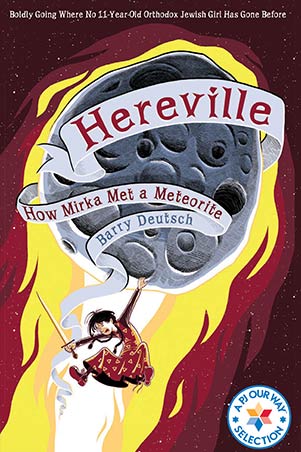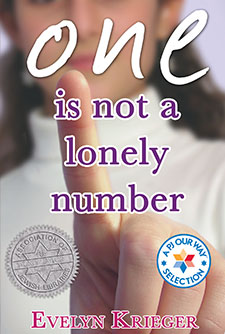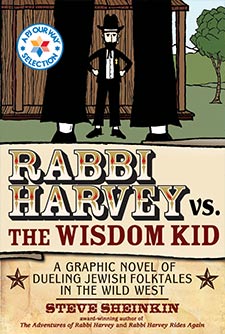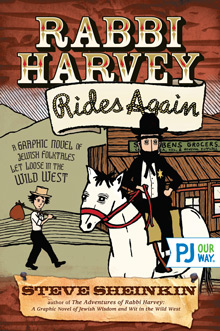Hereville: How Mirka Met a Meteorite
Meet Mirka, an Orthodox Jewish super-heroine! Can Mirka save Hereville from a meteorite and get rid of her evil twin before it's too late?
Average Rating
( hint: Login to leave a review! )
203 Reviews
Leave Review
What the Book is About
Jewish Content & Values
Positive Role Models
Content Advisory
Talk it Over!
More for You
What the Book is About
This offbeat graphic novel (the sequel to Hereville: How Mirka Got Her Sword ) is set in a fictional Jewish shtetl (Yiddish for a small Eastern European town with a large Jewish population) called Hereville. The heroine, Mirka, is not your typical shtetl girl. She despises knitting and dreams of fighting and slaying monsters ... although she’s not very good at it. When a witch creates her identical alter ego, Metty, Mirka must embrace her own awkward identity in order to get rid of the imposter.
Jewish Content & Values
- Hereville is a fictional shtetl: full-color drawings depict girls and boys in traditional Orthodox garb classic to the shtetl era; boys and girls attend separate schools; and colorful Yiddish words (translated in footnotes) are used throughout.
- Mirka and her family celebrate Shabbos (Yiddish for Shabbat – the Jewish day of rest). This is an important spiritual time for Mirka who tries hard to let go of her anger and bad feelings towards Metty.
- Mirka finds strength in the story of her great-great bubba (Yiddish for grandmother) who emigrated alone from Europe to America.
Positive Role Models
- Mirka takes responsibility for saving her town from the meteorite that the troll has unleashed, and when the witch seeks revenge, Mirka begs her to stop the cycle of violence.
- Rochel is Mirka’s helpful and practical stepsister. On more than one occasion, Rochel saves Mirka from Metty’s mean acts.
- Fruma is Mirka’s stepmother. She takes care of the family and finds creative ways to talk to Mirka about important issues.
Content Advisory
- Mirka’s mother died when Mirka was little, which could make some kids sad.
- There is a brief bullying scene where two boys tease Mirka and shove dirt in her mouth.
- Mirka makes a disparaging remark about the witch’s dress, which does not adhere to Mirka’s Orthodox standards of modesty.
- Some boys make a comment about negiah (Hebrew for "touch", which refers to the concept in Jewish law that forbids physical contact with a member of the opposite sex).
Talk it Over!
Fruma suggests to Mirka: “When you have to make a decision, imagine the person you want to be someday.” Do you think this is helpful advice? Why? Why not? Can you imagine the kind of person you want to be?
More for You
Hereville: When Mirka Met a Meteorite is full of witches, trolls, and magic. It is also full of references to modern Orthodox Jewish life. Interestingly, the two worlds sometimes overlap! In the Bible, King Saul, having had no luck communicating directly with God, visits a witch to help him confer with the dead Samuel (1 Samuel: 28). In the Talmud (Rabbinical commentary on the Bible), it is generally accepted that magic exists – it just should not be practiced. Rabbi Abaye (3rd c. Babylonian teacher) is quoted as saying, “the laws of sorcerers are like those of the Sabbath: certain actions are punished (by stoning), some are exempt from punishment, yet forbidden, whilst others are entirely permitted” (Sanhedrin 67b). He goes on to give the following example of permissible magic: “Rabbi Hanina and Rabbi R. Oshaia spent Shabbat studying the laws of Creation and then, when Shabbat was over, they created a calf and ate it!”
What the Book is About
What the Book is About
This offbeat graphic novel (the sequel to Hereville: How Mirka Got Her Sword ) is set in a fictional Jewish shtetl (Yiddish for a small Eastern European town with a large Jewish population) called Hereville. The heroine, Mirka, is not your typical shtetl girl. She despises knitting and dreams of fighting and slaying monsters ... although she’s not very good at it. When a witch creates her identical alter ego, Metty, Mirka must embrace her own awkward identity in order to get rid of the imposter.
Jewish Content & Values
Jewish Content & Values
- Hereville is a fictional shtetl: full-color drawings depict girls and boys in traditional Orthodox garb classic to the shtetl era; boys and girls attend separate schools; and colorful Yiddish words (translated in footnotes) are used throughout.
- Mirka and her family celebrate Shabbos (Yiddish for Shabbat – the Jewish day of rest). This is an important spiritual time for Mirka who tries hard to let go of her anger and bad feelings towards Metty.
- Mirka finds strength in the story of her great-great bubba (Yiddish for grandmother) who emigrated alone from Europe to America.
Positive Role Models
Positive Role Models
- Mirka takes responsibility for saving her town from the meteorite that the troll has unleashed, and when the witch seeks revenge, Mirka begs her to stop the cycle of violence.
- Rochel is Mirka’s helpful and practical stepsister. On more than one occasion, Rochel saves Mirka from Metty’s mean acts.
- Fruma is Mirka’s stepmother. She takes care of the family and finds creative ways to talk to Mirka about important issues.
Content Advisory
Content Advisory
- Mirka’s mother died when Mirka was little, which could make some kids sad.
- There is a brief bullying scene where two boys tease Mirka and shove dirt in her mouth.
- Mirka makes a disparaging remark about the witch’s dress, which does not adhere to Mirka’s Orthodox standards of modesty.
- Some boys make a comment about negiah (Hebrew for "touch", which refers to the concept in Jewish law that forbids physical contact with a member of the opposite sex).
Talk it Over!
Talk it Over!
Fruma suggests to Mirka: “When you have to make a decision, imagine the person you want to be someday.” Do you think this is helpful advice? Why? Why not? Can you imagine the kind of person you want to be?
More for You
More for You
Hereville: When Mirka Met a Meteorite is full of witches, trolls, and magic. It is also full of references to modern Orthodox Jewish life. Interestingly, the two worlds sometimes overlap! In the Bible, King Saul, having had no luck communicating directly with God, visits a witch to help him confer with the dead Samuel (1 Samuel: 28). In the Talmud (Rabbinical commentary on the Bible), it is generally accepted that magic exists – it just should not be practiced. Rabbi Abaye (3rd c. Babylonian teacher) is quoted as saying, “the laws of sorcerers are like those of the Sabbath: certain actions are punished (by stoning), some are exempt from punishment, yet forbidden, whilst others are entirely permitted” (Sanhedrin 67b). He goes on to give the following example of permissible magic: “Rabbi Hanina and Rabbi R. Oshaia spent Shabbat studying the laws of Creation and then, when Shabbat was over, they created a calf and ate it!”




